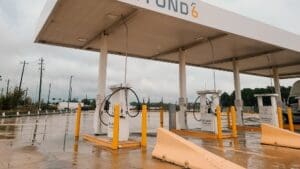
In September 2021, Chevron and Mercuria Energy Trading (Mercuria) formed a joint venture (JV) called Beyond6 with the goal to develop a compressed natural gas (CNG) network supplied with renewable natural gas (RNG). The JV’s first move was the purchase of 60 CNG stations across 17 US states from American Natural Gas, which were rebranded as Beyond6 stations. At the time, Chevron said it wanted to open more than 30 Chevron-branded CNG stations by 2025. In mid-November 2022, Chevron essentially completed that goal by signing a definitive agreement to buy out Mercuria’s portion of the Beyond6 JV, as well as remaining equity from Beyond6 CEO Andrew West. The transaction is subject to customary closing conditions. Beyond6 currently has about 55 operational CNG stations.
The stations range from two to eight fast-fueling lanes, operate 24/7, and can serve Class 8 trucks, passenger cars, trucks, and vans. “Chevron has seen strong demand for our RNG-to-CNG fuel offering from new and existing customers,” said Andy Walz, Chevron’s president of Americas Products. “Because of its carbon negative attribute and the ability of fleet operators to efficiently adapt vehicles to run on CNG, RNG can be a lower -carbon solution for fleets seeking to reduce their lifecycle greenhouse gas emissions.”

Although Mercuria will no longer have a stake in Beyond6, it will still be involved with the project. Mercuria and Chevron plan to enter into a long-term supply relationship, with Mercuria suppling RNG to Chevron for its fueling network. “Beyond6 represents a best-in-class operator in the build-out of a RNG network, and Mercuria has been excited to help the company grow from a standalone business to one that can help drive growth under Chevron,” said Brian A. Falik, Mercuria’s chief investment officer. “The partnership with Chevron has been a great success, and we look forward to helping them supply renewable fueling solutions to their customers.”
A Fast-Growing Alternative Fuel Portfolio
Since announcing its lower-carbon ambitions and 2030 targets in September 2021, Chevron has made several investments that complement its growing RNG and CNG portfolio. Chevron’s goal is to produce 40,000 MMBtu per day of RNG by 2030, increase its renewable fuels production capacity to 100,000 barrels per day, grow hydrogen production to 165,357 tons (150,000 tonnes) per year, and increase carbon capture and offsets to 27.56 million tons (25 million tonnes) per year. The targets fall under Chevron New Energies, which is the company’s novel division that addresses low-carbon investments. Renewable fuels and products are experiencing exponential growth. Between the launch of Chevron New Energies in 2021 and 2025, Chevron expects to grow its RNG portfolio by 10-fold, triple renewable diesel and sustainable aviation fuel production, and grow renewable base oil and lubricants production by 20-fold.
In addition to boosting its CNG fueling network, Chevron has also entered into JVs and supply agreements to increase its RNG production capacity. Brightmark RNG Holdings LLC (Brightmark) is a JV between Chevron and Brightmark LLC that develops RNG production projects in the United States. Brightmark is mainly focused on dairy biomethane projects. It delivered its first gas at Brightmark’s Lawnhurst site in western New York in November 2021. In January 2022, it announced plans to build an anaerobic digestion project at the Vlot Calf Ranch in Chowchilla, California. The Vlot Anaerobic Digestion project is expected to be completed in 2023. Chevron also markets its own RNG fueling stations in California through CalBioGas LLC, which is a JV between Chevron and CalBio. The JV made its first sale of RNG in 2020 and works with dairy farmers to produce and market RNG.
At the time of the Beyond6 acquisition, Chevron called out Brightmark and CalBioGas as two key RNG JVs in its renewable fuels and products portfolio. “Chevron is complementing the strength of its traditional products business with new offerings that help customers support a lower-carbon future, and RNG is an essential part of its portfolio of solutions,” said Chevron in a statement. “Through collaborations with Brightmark LLC and California Bioenergy LLC, Chevron is developing projects across the United States designed to convert fugitive methane emissions from dairies to a beneficial use as RNG, which can be considered carbon negative on a lifecycle basis under California’s Low-Carbon Fuel Standard [LCFS]. With this acquisition, Chevron can market the RNG it either produces or procures through a nationwide network of CNG locations.”
In addition to these JVs, Chevron’s US$3.15 billion acquisition of Renewable Energy Group (REG) in February 2022 significantly boosted its biofuels production capacity, mainly through biodiesel. Renamed Chevron Renewable Energy Group, the company operates 11 biorefineries in the United States and Europe. According to Chevron, Chevron Renewable Energy Group produced and delivered 480 million gallons (1.817 billion liters) of renewable fuels in 2021, which translated to an estimated 4.5 million tons (4.1 million tonnes) of carbon reduction. “We feel very good about where we are. We’re leveraging strengths across the entire value chain, from feedstock to customer. We’ve been a partner of choice for a lot of the dairy farmers,” said Chevron Chair and CEO Mike Wirth on the Chevron Q3 2022 earnings call when asked about Chevron’s RNG production, distribution, and delivery. “We’ve got a strong brand to pull through. We’ve got a really strong market position in California where the LCFS provides the strongest incentives for this. We’ve got 75 CNG sites online or in progress right now through the retail side. We’ve preferentially focused on dairy as opposed to landfill gas.”
Long-Term RNG Commitment
As of press time, California LCFS credit prices are US$62 per ton, a five-year low and a 57% decrease from a year ago that marks a drawdown of 71% from the five-year high. Given that Chevron is based in California and has deemed the state as the primary end market for its RNG and CNG business, LCFS prices directly impact the company’s profitability. Despite this relationship, Chevron has said it isn’t investing in CNG supplied by RNG based on LCFS credits. Rather, the company is making RNG investments to reach its multidecade net-zero goals. “In every one of our downstream businesses, we’re always working on reducing costs, improving technology, and finding ways to become more efficient,” said Wirth on the Chevron Q3 2022 earnings call in response to a question on falling LCFS prices. “The dynamics around LCFS credits, renewable identification numbers [RINs], AB32 credits in California, the EU trading scheme — all of these things, we have to manage through their own cycles. Part of our business is related to the fundamental supply demand dynamics that drive physical flows because you have government allocations of credits and whether people are building inventories or credits or drawing down inventories of these credits. And so, they don’t necessarily correlate with the underlying commodity. If you see the credits declining in value, it starts to erode a little bit of the margin in that business. We have to take a long-term view on these things. And I think the regulators do the same. And as they see credit values reflect a lot of length in credits, that suggests that the technology is advancing, the supply is advancing, and they can set more ambitious targets. And so, these things evolve over time.”
Multiple Paths Toward Decarbonization
In addition to its RNG and CNG investments, Chevron has been advancing its hydrogen portfolio. In October 2022, Chevron, Air Liquide, LyondellBasell, and Uniper SE announced the intent to collaborate on a joint study to assess the potential for hydrogen and ammonia production along the US Gulf Coast. In addition to the cost side of Chevron’s hydrogen, RNG, and CNG investments, Chevron noted that it is going to take time to build out the supply chains and experience necessary to make these fast-growing industries economically and environmentally sustainable. Although hydrogen, RNG, and CNG are not new industries (much of the technology has been around for decades), the current supply chain is not fit for a nationwide surge in production, transportation, storage, and distribution of alternative fuels in a way that complies with regulations. “We’re excited about the announcements to work with a number of really good partners to try to develop hydrogen opportunities there on the Gulf Coast,” said Wirth on the Chevron Q3 2022 earnings call. “One of the things I think you’re going to see in these [Chevron] New Energies businesses as they evolve is we’re going to have to build entire new value chains. And that means we’re going to partner with different people who have expertise in different parts of these value chains and can bring technology, can bring customers, can bring experience to a venture that no one company necessarily would have all of that, but collectively, we can work with people that can build these new value chains. We’re studying all the different opportunities in terms of blue hydrogen, green hydrogen, there’s a lot of different colors possible as you get down into the details of it. And it will require significant investments. So, I don’t want to get ahead of ourselves here. This is to really develop well-informed perspectives on the investment opportunities, the business models, and ultimately, how we would build the business up there. But it’s exciting. They’re high-quality partners that we are working with. We’ve got a lot we’re working on around the world, not just here in the United States.”
















